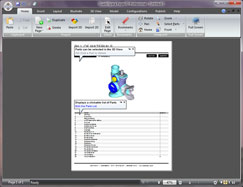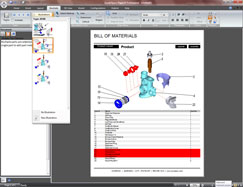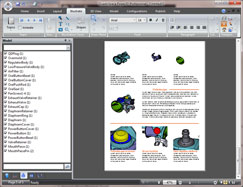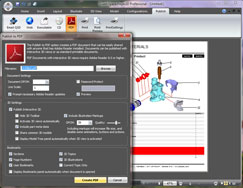With the increasing ubiquity of 3D data, attention inevitably turns to realising its full value, often by streamlining related but historically non-CAD workflows. The QuadriSpace product suite provides tools for non-engineering personnel to utilise CAD data and generate a range of content rich product information. Most importantly it enables this to be done without having to have any knowledge of the model generation process.
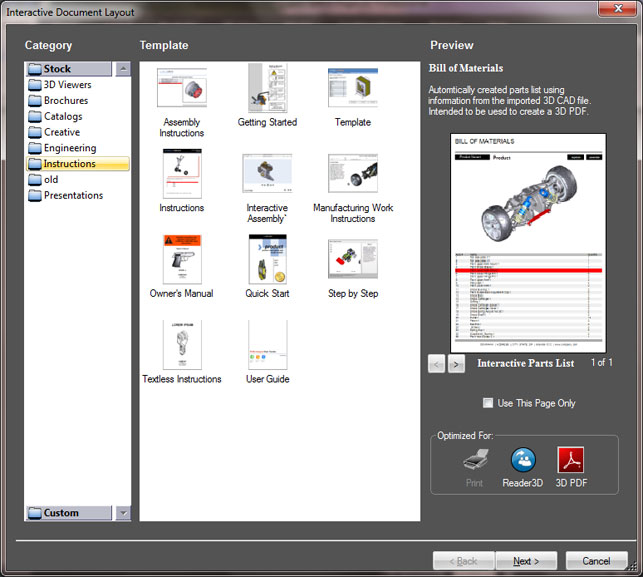
A range of supplied or custom templates can be selected including, in the Professional products, Smart Template Technology to rapidly populate models into the document
The Quadrispace product range is primarily packaged up by groups of functionality, aimed at discrete target user groups. There are two key product families – Pages 3D and Publisher 3D – both of which are based on a core, shared set of 3D model manipulation tools.
Pages 3D integrates 3D data with 2D desktop publishing (DTP) style functionality for multipage printed or interactive document authoring. These include manufacturing instructions, user guides, illustrated parts lists, service procedures and marketing brochures.
Publisher3D focuses on technical illustration and product animation creation, enabling existing 3D data to be used as the basis for a wide range of graphic, animation or document formats without having to start again from scratch.
Combining both of these products and providing a full set of communication and documentation tools, QuadriSpace also offers the Document3D Suite.
While this may appear straightforward, unfortunately QuadriSpace complicates matters by introducing three levels of functionality to each product. Starting with the ‘Basic’ level, additional functionality is then added to ‘Standard’ and ‘Professional’ versions. We’ll look at each of these in turn.
The Basic level
There is only one product available at the basic level, the Document 3D Suite Basic Edition. This provides essential tools to integrate and edit 3D and text based content in a single publishing environment. The interface is similar to the Microsoft Office 2007 task-specific ribbon and customisable quick access toolbars although extended property panels dock to the left of the screen rather than floating as dialogs.
In edit page mode, text and 3D view boxes can be positioned and resized and body text edited and formatted. As objects are placed, pop up balloons describe the object and provide hyperlinks for further actions such as importing a 3D model into a 3D view.
3D PDF documents and web pages can be generated including views with descriptive annotations that display when views or bookmarks are selected. 3D data from a wide range of sources including SolidWorks, Inventor, DWF, STL, Google SketchUp, DWG, DXF and 3ds Max can be imported and the software includes the ability to move and section parts, specify materials and set render style – semi-transparent, hidden detail, rendered with edges etc.
This functionality represents good value 3D document publishing compared to the Adobe Acrobat equivalent. An optional module that facilitates the import of Pro/Engineer, STEP, IGES, SAT, Parasolid and VDA data is available at an additional cost.
The Standard level
A significant quantity of additional 3D tools are introduced in the Standard level products, many of direct relevance to manufacturing users. A number of exploded view tools are available ranging from auto explode to full manual control with the option to include customisable trail lines, straight or stepped, if required.
Control over BOM tables is also extensive. Auto inserted tables can be linked to specified model views so that selecting a part in the table or the 3D view highlights the other. An Excel style editor enables columns to be added, for example to include non-modelled parts such as glue, or removed and rows can be moved up or down the list with call out numbers updating accordingly in the 3D view.
Call outs can be added manually, for selected parts or, conveniently, just all visible parts. They can be auto arranged according to a palette of layout options or probably more successfully dragged manually. In addition to using properties directly from the model, BOM data can be imported from PDM systems and can also be exported to an Excel, XML or CSV file.
Customised 3D views can be captured as illustrations including orientation, zoom, render style, explode and annotation details. Since in complex documents there can be numerous illustrations these can be organised logically into topics or in a timeline on a storyboard incorporating timing and transition details, typically where the output is intended to be an animation.
Breaking this down into product groups, Pages 3D Standard provides document authoring, either for print or interactive applications including full BOM information, dynamically linking graphic and table display and step through assembly or operating sequences. Publisher 3D Standard can output a sequence of high resolution annotated images, AVI or Flash animations.
The Professional level
Capabilities available in the Professional level products include the ability to manage, import and, if required, merge multiple 3D models, even from multiple CAD systems, enabling units to be specified as necessary. Given the potential complexity of model data key functions are configurations and update tools, which are used to manage synchronisation between design and document iterations.
Configurations are used to manage large projects by creating assembly subsets, aiding multiple merged models management, facilitating rapid switching between product variants such as colour ways and controlling visibility of ancillary items such as jigs and fixtures. Definitions can specify part visibility location and materials and can include multiple exploded views, parts lists and illustrations. Configurations can be readily generated simply from parts currently visible.
Once a considerable amount of product documentation has been generated it is critical to be able to manage design data updates effectively. An Update tool enables specific part files to be selected and alternate filenames to be specified if a non PDM CAD revision schema relies on a file naming convention.
Changes then ripple through all illustrations, potentially saving a huge amount of time whenever a design revision occurs. Although file version data is available in the QuadriSpace environment, the ability to publish revision details directly into published documents would be a welcome enhancement.
A key feature in the Pages3D Professional product is the Smart Template Technology, which enables multiple pages of content to be automatically generated. By selecting appropriate, customisable templates, consistently formatted images of each constituent component in an assembly, or step-by-step sequences from a prepared exploded view, can be generated with no manual intervention. This produces a document ready for the addition of any required text based information.
Publisher3D Professional includes the ability to output vector data as well as raster graphics and XML format data including DITA (Darwin Information Typing Architecture).
Conclusion
QuadriSpace offers great integration of 3D CAD and publishing tools into a single environment with a critical ability to ripple model changes through documents irrespective of complexity. The product module structure seems inexplicably complex and at times interaction is less than intuitive but for a standalone tool to rapidly publish comprehensive printed or interactive product documentation the demo at document3d.com/downloads is well worth a look.
| Product | Document3D Suite |
|---|---|
| Company name | www.quadrispace.com |
| Price | On application |


